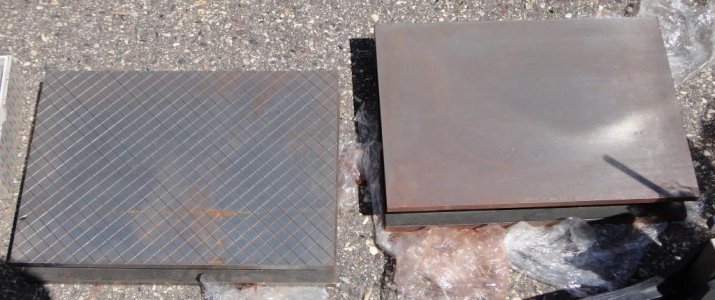I think this might be the appropriate place to ask for advice on this subject. If not, let me know and well see about getting it moved.
As part of a Craig's List "take everything that is in the box or nothing" purchase I acquired what appear to be two cast iron 14 x 10 surface plates. One of the two has a cross hatched surface on one side, with the other three surfaces being flat. Even though they were wrapped in plastic wrap they seem to have have collected a little surface rust.
Before I do anything with them I was hoping to get some advice and\or a plan of attack to bring these back to a reasonable life. I have both a 12 x 18 x 3 and a 9 x 12 x 2 ubiquitous Grade B granite surface plate but do not have any scraping tools. I will be honest in that I am not looking to create AA grade plates out of them, just something a home hobbyist would find acceptable.
Any suggestions ... even starting with something as simple as "What should I do to just clean them up?" and "After you get them clean perform these test to assess how good\bad they might be." I am assuming that any planning beyond that would be based purely on speculation of condition, but feel free to "best case scenario and worst case scenario" if you have the time.

Thanks,
Arvid

As part of a Craig's List "take everything that is in the box or nothing" purchase I acquired what appear to be two cast iron 14 x 10 surface plates. One of the two has a cross hatched surface on one side, with the other three surfaces being flat. Even though they were wrapped in plastic wrap they seem to have have collected a little surface rust.
Before I do anything with them I was hoping to get some advice and\or a plan of attack to bring these back to a reasonable life. I have both a 12 x 18 x 3 and a 9 x 12 x 2 ubiquitous Grade B granite surface plate but do not have any scraping tools. I will be honest in that I am not looking to create AA grade plates out of them, just something a home hobbyist would find acceptable.
Any suggestions ... even starting with something as simple as "What should I do to just clean them up?" and "After you get them clean perform these test to assess how good\bad they might be." I am assuming that any planning beyond that would be based purely on speculation of condition, but feel free to "best case scenario and worst case scenario" if you have the time.

Thanks,
Arvid


